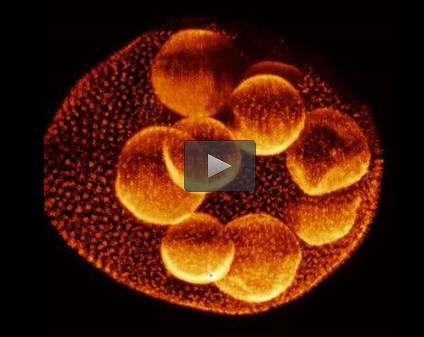Upside down and inside out

Researchers have captured the first 3-D video of a living algal embryo turning itself inside out, from a sphere to a mushroom shape and back again. The results could help unravel the mechanical processes at work during a similar process in animals, which has been called the 'most important time in your life.' Credit: Stephanie Höhn, Aurelia Honerkamp-Smith and Raymond E. Goldstein
Using fluorescence microscopy to observe the Volvox embryos, the researchers were able to test a mathematical model of morphogenesis – the origin and development of an organism's structure and form – and understand how the shape of cells drives the process of inversion, when the embryo turns itself from a sphere to a mushroom shape and back again. Their findings are published today (27 April) in the journal Physical Review Letters.
The processes observed in the Volvox embryo are similar to the process of gastrulation in animal embryos – which biologist Lewis Wolpert called “the most important event in your life.” During gastrulation, the embryo folds inwards into a cup-like shape, forming the primary germ layers which give rise to all the organs in the body. Volvox embryos undergo a similar process, but with an additional twist: the embryos literally turn themselves right-side out during the process.
Gastrulation in animals results from a complex interplay of cell shape changes, cell division and migration, making it difficult to develop a quantitative understanding of the process. However, Volvox embryos complete their shape change only by changing cell shapes and the location of the connections between cells, and this simplicity makes them an ideal model for understanding cell sheet folding.
In Volvox embryos, the process of inversion begins when the embryos start to fold inward, or invaginate, around their middle, forming two hemispheres. Next, one hemisphere moves inside the other, an opening at the top widens, and the outer hemisphere glides over the inner hemisphere, until the embryo regains its spherical shape. This remarkable process takes place over approximately one hour.
Previous work by biologists established that a specific series of cell shape changes is associated with various stages of the process. “Until now there was no quantitative mechanical understanding of whether those changes were sufficient to account for the observed embryo shapes, and existing studies by conventional microscopy were limited to two-dimensional sections and analyses of chemically fixed embryos, rendering comparisons with theory on the dynamics difficult,” said Professor Raymond E. Goldstein of the Department of Applied Mathematics and Theoretical Physics, who led the research.
The interdisciplinary group of Cambridge scientists obtained the first three-dimensional visualisations of Volvox inversion and developed a first mathematical model that explains how cell shape changes drive the process of inversion.
Their time-lapse recordings show that during inversion one hemisphere of the embryos shrinks while the other hemisphere stretches out. While previous studies on fixed embryos have also observed this phenomenon, the question was if these changes are caused by forces produced within the invaginating region, or from elsewhere in the embryo.
Through mathematical modelling, the researchers found that only if there is active contraction of one hemisphere and active expansion of the other does the model yield the observed 'mushroom' shape of an inverting Volvox globator embryo.
“It's exciting to be able to finally visualise this intriguing process in 3D,” said Dr Stephanie Höhn, the paper's lead author. “This simple organism may provide ground-breaking information to help us understand similar processes in many different types of animals.”
These results imply that any cell shape changes happening away from the invagination region seem to be due to active forces intrinsic to the cell, rather than through passive deformations. Since analyses in animal model organisms mostly concentrate on cell shape changes that happen within an invaginating region, the model could be used to make those analyses far more accurate.
“The power of this mathematical model is that we can identify which cell deformations are needed to cause the embryo movements that we observe in nature,” said Dr Aurelia Honerkamp-Smith, one of the study's co-authors.
The experimental and theoretical methods demonstrated in this study will be expanded to understand not only the peculiar inversion process but many mysteries concerning morphogenesis. The mathematical model may have applications in a multitude of such topological problems, such as the process of neurulation that leads to the enclosure of the tissue that eventually becomes the spinal cord.
###
Other members of the research team were PhD students Pierre A. Haas (DAMTP) and Philipp Khuc Trong (Physics).
This work was supported by an Earnest Oppenheimer Early Career Fellowship, the EPSRC, and the European Research Council.
Media Contact
All latest news from the category: Physics and Astronomy
This area deals with the fundamental laws and building blocks of nature and how they interact, the properties and the behavior of matter, and research into space and time and their structures.
innovations-report provides in-depth reports and articles on subjects such as astrophysics, laser technologies, nuclear, quantum, particle and solid-state physics, nanotechnologies, planetary research and findings (Mars, Venus) and developments related to the Hubble Telescope.
Newest articles

NASA: Mystery of life’s handedness deepens
The mystery of why life uses molecules with specific orientations has deepened with a NASA-funded discovery that RNA — a key molecule thought to have potentially held the instructions for…

What are the effects of historic lithium mining on water quality?
Study reveals low levels of common contaminants but high levels of other elements in waters associated with an abandoned lithium mine. Lithium ore and mining waste from a historic lithium…

Quantum-inspired design boosts efficiency of heat-to-electricity conversion
Rice engineers take unconventional route to improving thermophotovoltaic systems. Researchers at Rice University have found a new way to improve a key element of thermophotovoltaic (TPV) systems, which convert heat…



